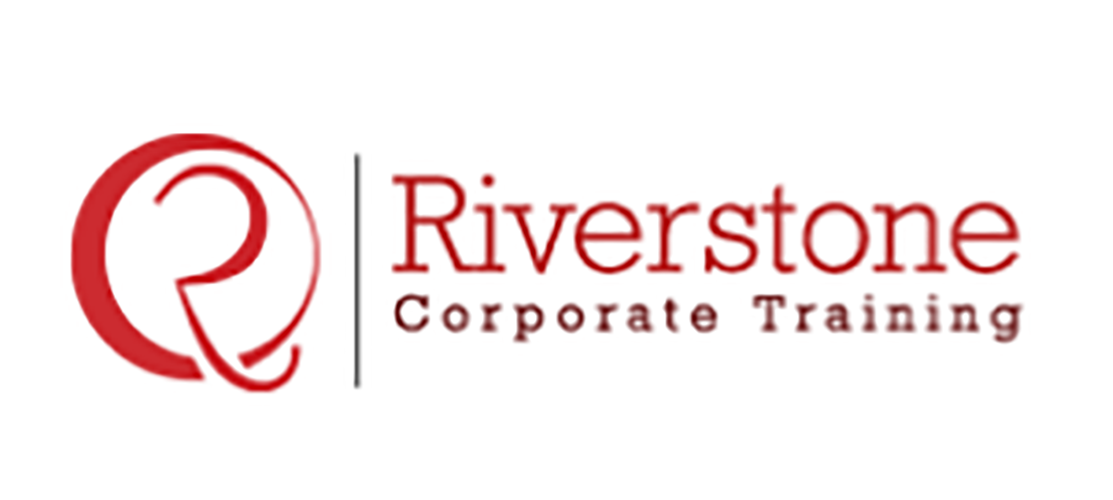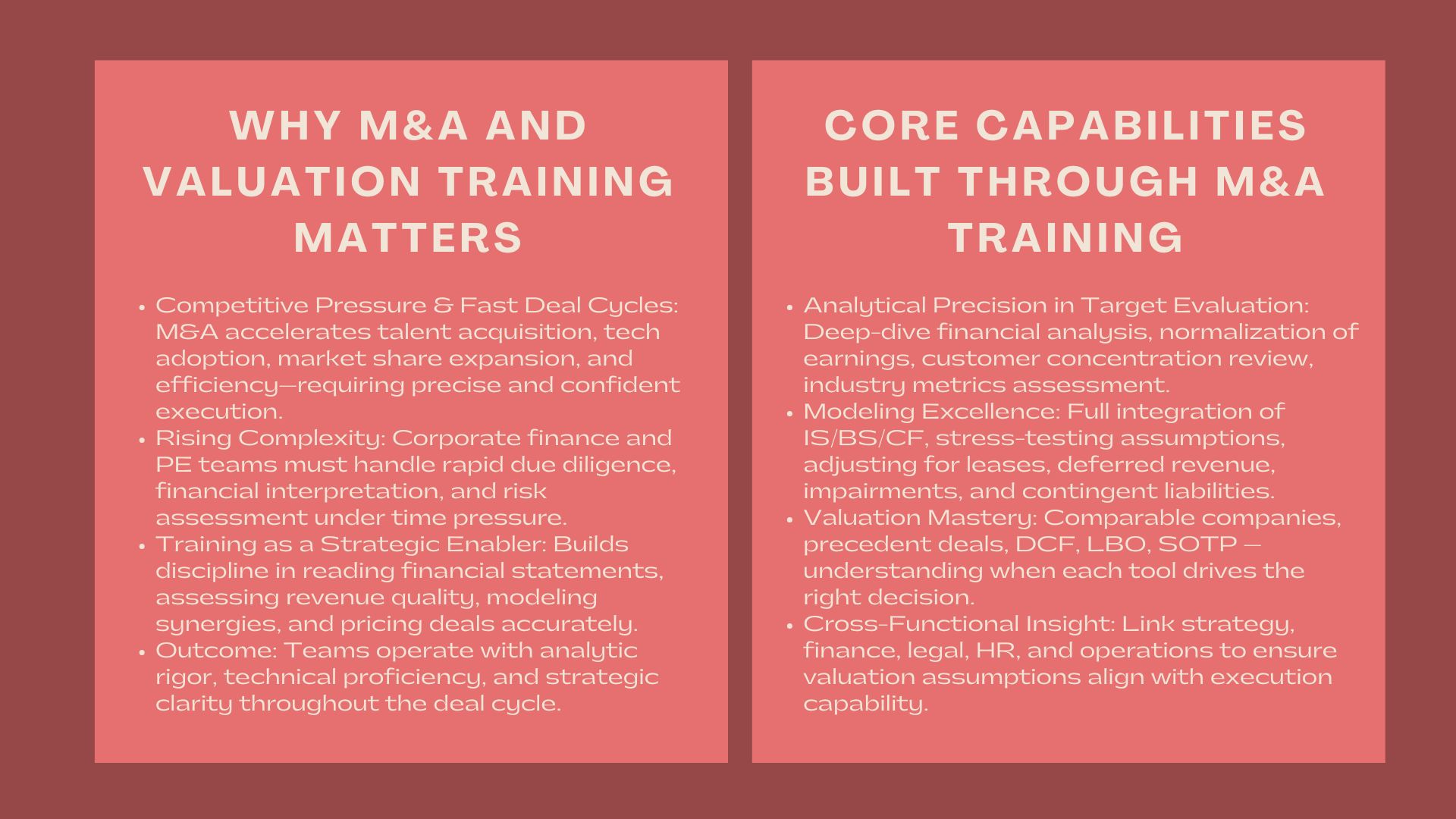M&A and Valuation Training for Private Equity and Corporate Transactions
Introduction to Advanced MA Valuation Skills Training
Competitive strategy in industries remains a factor that is being influenced by mergers and acquisitions, which compel companies to gain talent, technology, market share, and operational efficiency. The pressures on the deal cycle and valuation become more complicated due to the speed of deals and the necessity to implement transactions with precision and confidence, which places further pressure on the corporate finance team and the private equity firm.
This is a climate that has necessitated sophisticated M&A and valuation training among the practitioners who are supposed to interpret financial statements, model synergies, calculate the risk of the deal and find the appropriate price of an acquisition. The quality of training programs guarantees that it is through these responsibilities that the teams can move with discipline, technical proficiency, and strategic understanding.
The subsequent sections examine the role of systematic M&A training in enhancing the transactional skills, the essential ingredients of a successful valuation training programs, and practical uses of the skills to the context of a private equity and corporate deal setting.
1. Enhancing Readiness to Transactions With Practical M&A Training.
1.1 In the initial section, I am going to create analytical precision in deal evaluation.
To the analysts of the private equity, corporate development teams, and financial managers, the initial difficulty of any transaction is to duly evaluate the target company. The training programs equip individuals to assess previous performance, normalize revenues, and customer concentration, and industry-specific pointers. Financial statement deep dives are frequently included in the programs, with revenue quality, cost structures, working capital requirements, and capital expenditure cycles being the key elements of the programs.
During these sessions, the instructors present the frameworks of measuring competitive positioning, scalability and value creation potential. Participants learn using real deal cases when participants entered into deals with mismatched assumptions, which resulted in valuation conflicts like excessively optimistic synergy estimates or missing liabilities. Through studying such cases, teams develop the ability to spot red flags early and create an objective picture of both financial and operational reality of a target.
Within this stage of the training, instructors integrate the first required keyword naturally into the modeling section by discussing how m&a modeling and valuation techniques for private equity transactions help teams align technical analysis with investment criteria.
1.2 Enhancing Cross-Functional Decision-Making
M&A implementation must involve strategy, finance, legal, operations, and human resource. The training programs assist in bridging the communication gaps that do occur between these functions. The participants will be taught to use the financial models in making decisions about the legal structuring, the impact of operational due diligence on valuations, and the level of risk teams to judge regulatory exposures.
Practical cases would involve acquisitions where integration planning was slow because of poor communication or valuation assumptions being unresponsive to operational constraints. The above scenarios illustrate the necessity of cross-functional insight in order to have smooth, value-accretive deals.
2. Deal execution: Valuation and Modeling Techniques.
2.1 Constructing Sustainable Deal Model of a Lived-in Deal.
M&A decision-making is based on financial modeling. Professionals are directed in training programs to all levels of a deal model, including the construction of historical schedules to stressing forecasts. Participants are taught to create integrated income statements, balance sheets and projection of cash flows using real world datasets. Adjustments which are covered during the training include deferred revenue, asset impairments, lease capitalization and contingent liabilities.
The lessons that are learned during these workshops emphasise the significance of assumptions based on market information, whether competitive pricing, commodity cycles, customer churn, or acquisition synergies. The participants learn of warning signs of transactions in which excessive revenue growth or underestimated integration expenses intent on the write-down of post-acquisition. Through simulation of these situations, trainees learn the discipline that prevents these traps of valuation.
2.2 Multiple Valuation Appraisals as Strategic Decision Making.
In addition to financial modeling, M&A training illustrates to the participants on how to utilize and read various approaches of valuation. Similar company analysis, past dealings, DCF analysis, LBO frameworks, and sum-of-the-parts techniques all provide an alternative viewpoint of the value of the target. Training is important in order to make sure that the participants are able to know when and why to use each method.
As an example, the precedent transactions can prove to be handy when determining the premiums in the acquisition in case of competition in the market whereas the DCF models give an insight of the sustainability of the cash flow in the long run. LBO modeling, which is especially important to the participants of the private equity, would assist in figuring out the viability of leveraged transactions. The practical case studies of selection of an incorrect valuation technique or given the inputs of the model can lead to the distortion of the price expectations and the negotiation process.
The second required keyword, mergers and acquisitions financial modeling workshop for corporate finance teams, is typically introduced when describing advanced modules that align valuation tools with the needs of corporate dealmakers.
3. Applying M&A Skills to Private Equity Investment Cycles
3.1 Screening Opportunities and Building Investment Cases
To sieve opportunities and concentrate on deals that yield strategic and financial goals, private equity investors base on structured investment theses. The training programs assist the analysts in assessing industry attractiveness, intensity of competition, customer dynamics, and inorganic expansion avenues. The participants are taught to transform these insights into data-driven screening structures.
An example is the workshops that can be used to analyze the buyout opportunities within the healthcare services industry, logistics, or financial technology. The participants evaluate the market position of the investment in terms of operational improvements, market consolidation or product extensions. These are exercises that are similar to the strategic assessment carried out by actual investment committees.
3.2 Competent Negotiations through Accurate Valuation Logic.
The success of the negotiation process is determined by the presentation of the valuation outcomes in a clear and credible way. Training programs help professionals to communicate the motivation behind their valuation decisions, defend premium levels, and debate the assumptions made by counterparties using factual arguments. Negotiations involving buyers utilizing granular working capital knowledge, customer profitability examination, or reduction cost benchmarks are frequently included in case studies.
The same applies to corporate transactions. Finance departments will be required to provide valuation results to executives and boards and how valuation ranges and strategic synergies, timing of integration, or regulatory effects determine valuation effects. It is through training that there is the ability to put across these insights in a concise and confident manner.
4. Finding the way to prepare Corporate Teams to create value after the merger.
4.1 The alignment between the Integration Plans and the Valuation Assumptions
One of the most frequent causes of deal failure to give expected returns is that the assumptions made in valuation models do not correspond with integration plans. This gap is filled in the training programs. The participants are taught the way to turn the estimates of synergy into the operational projects and resource planning. They also discuss the situation where system integration or leadership change delays impact value creation schedules.
An example that is observable in the real-life scenario is that in mergers where the acquirer had overestimated cost-efficiencies or underestimated cultural differences, the integration process was slower and the overall performance was weak. These cases enable the trainees to know why integration planning should start at due diligence- not after the deal is closed.
4.2 Performance Monitoring and Realigning Strategic Priorities.
Companies have to be very strict in the measurement of performance once a transaction is completed. Training educates teams on how to quantify the accomplishment of synergy, track the cash outburst, and redefine value drivers as the market continues to change. The participants are trained to create post-merger dashboards, oversight integration teams, and resolve issues in their early stages.
Large-cap acquisitions are especially likely to feature instances where integration measures were not met because the tracking was inadequate or where the value could be regained through quick actions. These understandings build the capacity of the participants in ensuring that they are disciplined throughout the post-deal lifecycle.
Conclusion
With the increase in competition and more complex deal structures, M&A and valuation training are a necessity to the corporate finance team and the professionals of the private equity. Technical modeling, strategic judgment and the communication skills required to facilitate negotiations and integration planning are all formed through high-quality programs. Investment in real-world training helps organizations to become stronger in terms of evaluating opportunities, risks, and carrying out transactions that deliver a long-term value. Further evolution of dealmaking will require more analytical rigor and cross-functional team work and flexibility, and continuing training will be necessary to remain competitive in an ever-changing M&A world.


